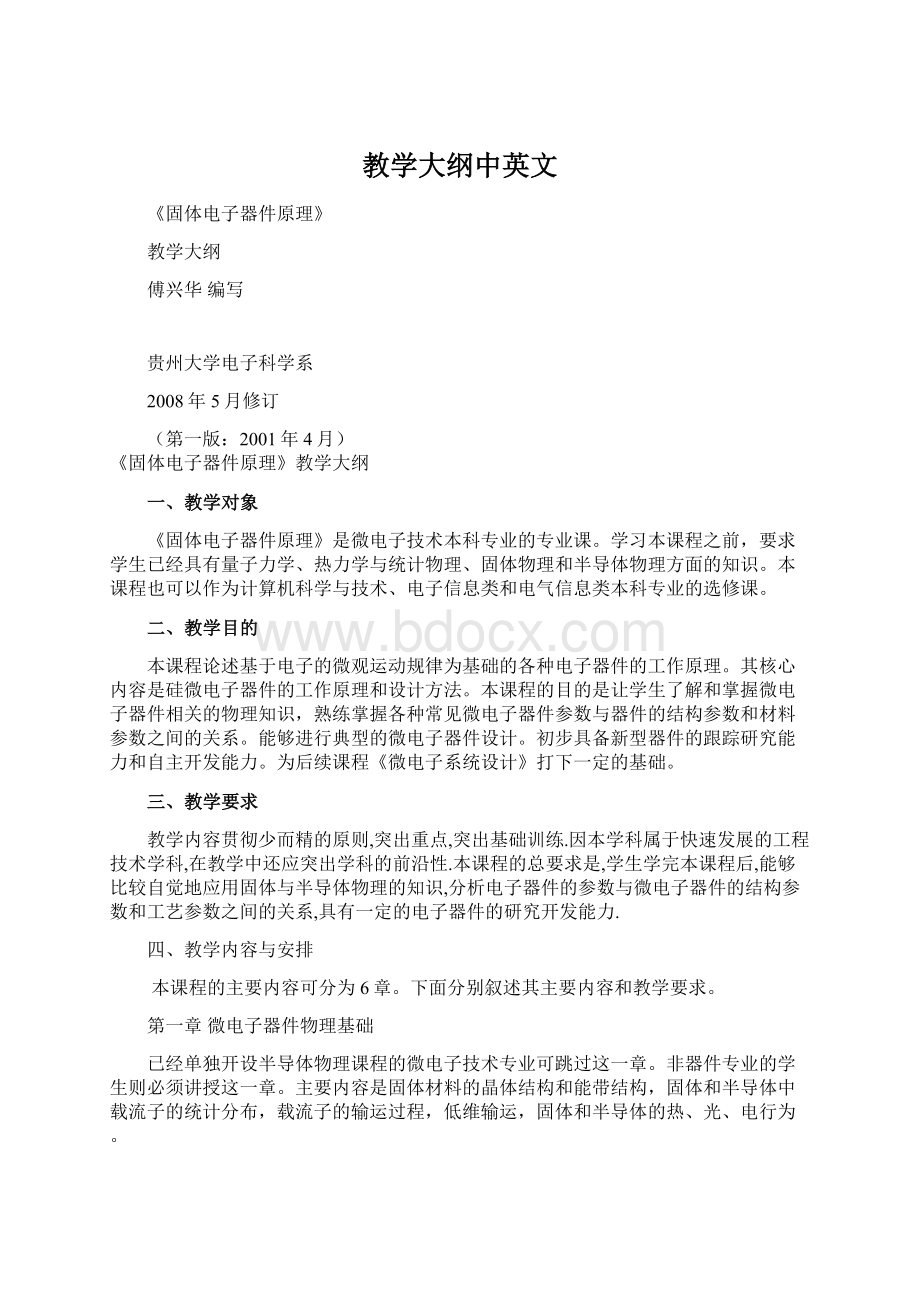教学大纲中英文Word文档下载推荐.docx
《教学大纲中英文Word文档下载推荐.docx》由会员分享,可在线阅读,更多相关《教学大纲中英文Word文档下载推荐.docx(10页珍藏版)》请在冰豆网上搜索。

其核心内容是硅微电子器件的工作原理和设计方法。
本课程的目的是让学生了解和掌握微电子器件相关的物理知识,熟练掌握各种常见微电子器件参数与器件的结构参数和材料参数之间的关系。
能够进行典型的微电子器件设计。
初步具备新型器件的跟踪研究能力和自主开发能力。
为后续课程《微电子系统设计》打下一定的基础。
三、教学要求
教学内容贯彻少而精的原则,突出重点,突出基础训练.因本学科属于快速发展的工程技术学科,在教学中还应突出学科的前沿性.本课程的总要求是,学生学完本课程后,能够比较自觉地应用固体与半导体物理的知识,分析电子器件的参数与微电子器件的结构参数和工艺参数之间的关系,具有一定的电子器件的研究开发能力.
四、教学内容与安排
本课程的主要内容可分为6章。
下面分别叙述其主要内容和教学要求。
第一章微电子器件物理基础
已经单独开设半导体物理课程的微电子技术专业可跳过这一章。
非器件专业的学生则必须讲授这一章。
主要内容是固体材料的晶体结构和能带结构,固体和半导体中载流子的统计分布,载流子的输运过程,低维输运,固体和半导体的热、光、电行为。
要求器件专业的学生从定性和定量两方面掌握和应用本章的知识,而对非器件专业的学生,则要求定性理解本章的内容,并熟悉简单的定量关系。
第二章pn结
本章是器件原理中十分重要的一章,务必要求学生熟练掌握和应用本章的知识。
主要内容包括,pn结特性的定性描述和定量描述,pn结的直流特性,pn结的寄生效应,pn结的交流小信号特性及其等效电路,pn结的开关过程及其物理实质,pn结的击穿模型及其定量描述。
金属-半导体接触放在本章介绍。
各种结构的能带图,用泊松方程求解pn结问题和载流子在pn结内的输运原理是本章的两个重点。
具体要求是:
深刻理解和画出各种偏置条件下pn结、金属-半导体接触的能带图;
理解和掌握准费米能级的概念和应用;
熟练计算pn结的接触电势差;
深刻理解和掌握pn结直流特性的有关概念和计算问题;
熟练计算pn结的空间电荷区宽度和势垒电容;
熟练计算pn结的开关过程参数;
掌握和计算pn结击穿的有关理论和计算问题。
要求学生课外完成30道左右有一定难度的习题。
第三章双极型晶体管
本章包括了传统晶体管原理的主要内容,是学生必须熟练掌握的内容。
通过本章的学习,学生对于微电子器件原理的分析和应用能力将得到进一步的提高。
本章内容主要包括双极型晶体管内载流子的输运过程,双极型晶体管的直流特性、频率特性、功率特性和开关特性。
要求重点掌握和理解双极型晶体管的能带图,载流子的输运过程、直流特性和频率特性几方面的内容。
根据给定结构参数和材料参数,计算双极型晶体管的发射结注入效率、基区输运系数、α、β、基极电阻等直流参数;
渡越时间、截止频率等交流参数;
解释和计算发射极电流集边效应和基区宽度扩展效应等功率晶体管的有关问题;
解释和计算晶体管的极限参数如击穿电压、最大耗散功率等;
计算晶体管的开关参数。
了解双极型晶体管技术和工艺的新进展。
第四章场效应晶体管
由于现代集成电路中的器件绝大多数都是场效应晶体管,因此本章的学习显得尤为重要。
本章分为结型场效应晶体管(JFET)和绝缘栅场效应晶体管(IGFET或MOSFET)两部分。
结型场效应晶体管部分可以略讲,重点放在绝缘栅场效应晶体管部分。
掌握涉及JFET的电流电压方程的有关问题;
掌握JFET的短沟道效应的有关概念和物理模型,了解JFET交流特性和参数。
掌握MOS二极管的实验原理和方法,MOS二极管C-V特性的重要意义和应用范围;
深刻理解阈电压各项的物理意义,熟练掌握MOSFET阈电压的计算;
掌握MOSFET电流电压方程、直流参数和交流参数的有关计算问题。
理解亚阈区导电原理、物理模型和计算方法。
深刻理解和掌握各种短沟道效应的物理模型、分析方法。
了解MOSFET的按比例缩小理论和重要意义。
了结亚微米、深亚微米MOSFET发展的最新动向。
要求学生课外完成30道左右有一定难度的习题,阅读有关MOSFET最新进展的文献5万字以上。
了解MOSFET晶体管技术和工艺的新进展。
第五章光电子器件
半导体激光器件与发光器件在现代信息社会中扮演着十分重要的角色,是微电子技术和光电子技术的桥梁和纽带,是最为活跃的研究领域之一。
本章要求学生掌握常用半导体激光和发光器件的制造工艺、工作原理和主要参数,并了解这些器件的应用领域。
本章的教学方式为讲座式和讨论式。
课外作业为阅读有关最新进展的论文和论文综述。
第六章功率器件
本章主要学习双极型功率器件、MOSFET功率器件和可控硅三方面的内容。
鉴于学生通过前述章节的学习,已经掌握了固体器件原理的基本方法,本章有学生讲授、课堂讨论的形式完成。
学时安排
总学时数为80学时,其中课堂教学72学时。
第一章微电子器件物理基础8学时;
第二章pn结,金属半导体接触,16学时;
第三章双极型晶体管12学时,专业文献阅读和讨论2学时;
第四章场效应晶体管20学时,专业文献阅读和讨论4学时;
第五章光电子器件4学时,专业文献阅读和讨论2学时;
第六章功率器件,文献阅读和讨论4学时。
专业文献阅读和讨论学时数也可集中使用。
五、测试
测试内容分为概念、计算和开放式论述,以及课程设计三个方面。
概念题和计算题主要检查学生掌握所学知识的面、牢固程度和综合应用所学知识解决一般问题的能力,以闭卷考试的形式进行。
概念题占40%,计算题占60%,考题在题库中抽取。
题库大小为不低于250道题,其中概念题不低于100道。
开放式论述题考查学生对已学知识的综合应用能力和应用已有知识去获取新知识的能力,以开卷考试论文式考题的形式进行。
课程设计结合集成电路设计和微电子工艺实验进行。
六、参考书目
1.半导体物理学,刘恩科等待,国防工业出版社,94年版.
2.C.KittelIntroductiontosolidstatephysics
3.DonaldA.Neamen:
SemiconductorPhysicsandDevices:
BasicPrinciple,ThirdEdition.清华大学出版社,2003年影印版。
4.S.M.Sze,PhysicsofSemiconductorDevices,Secondedition.
6.半导体器件学术论文选读。
7.傅兴华等编《半导体器件原理》讲义1994年本。
8.浙江大学半导体教研室编《晶体管原理》国防工业出版社1980年6月第一版。
七、教学中应注意的问题
教学中正确处理基础知识教学与文献阅读之间的关系,专业文献阅读必须在学生已经较为牢固地掌握基础知识的前提下进行,各章的教学重点一定要与固体与半导体物理的知识结合起来,讲深讲透。
专业文献的阅读除了让学生了解本学科的前沿之外,还应对学生基础知识的学习起巩固作用和引导作用。
文献的选择除了要确实能反映学科前沿外,还应注意难易适当,阅读量适中,保证学生能在教师的辅导下真正读懂原文。
CourseProgrammefor
SolidStateElectronicDevices
1.TheObjectoftheCourse.
PrincipleofMicro-electronicsDeviceisthecoursedesignedfortheundergraduatestudentsofmicro-electronicstechnologyspecialty.Beforetakingthisclass,thestudentsarerequiredtohavetheknowledgeofquantummechanics,thermodynamicsandstatisticalphysics,solidstatephysicsandsemiconductorphysics.Thiscoursecanalsobetakenbythestudentsofcomputerscienceandtechnology,electronicinformationandelectricinformation.
2.ThePurposetheCourse
Theclasswilldiscusstheprinciplesofworkingofallkindsofelectronicdevicesbasedonthemicroscopicmovementofelectron.Themaincontentwillbetheprincipleofworkingandthemethodofdesignofsilicon-baseddevices.Thepurposeistoletthestudentsunderstandandmasterphysicalknowledgerelatedtothemicroelectronicdevices,skillfullymasterallkindsofrelationsofdevicesparameterswithstructuralparameterandmaterialparameter.Thestudentsarerequirestobeabletodesignsometypicaldevices,alsotheywillbeabletohavethebasicabilitytofollowanddevelopnewdevices.Thiscoursewillalsomakethestudentsreadyforthefollowingcourseofthedesignmicroelectronicsystem.
3.TheRequirementoftheTeaching
Themaincontentofteachingshouldemphasizethemainpoints,basictraining.Becausethismajorisinthefieldofengineeringandtechnologywhichisstilldevelopingfast,thereforethecutting-edgeofthisareashouldbeemphasizedintheteaching.Thegeneralrequirementofthiscourseisthefollowing:
Aftertakingthiscourse,thestudentswillbeabletousetheknowledgeofsolidstatephysicsandsemiconductorphysics,tobeabletoanalyzetherelationbetweenelectronicdevicesparameters,microelectronicdevicestructuralparameterandmaterialparameter,tobeabletodoresearchanddevelopofelectronicdevices.
4.TheContentandArrangementoftheTeaching
Thecontentofthiscoursewillbetaughtinsixchapters,thefollowingwillbethedetail.
Chapter1TheBasicPhysicsofMicroelectronicDevices.
Thoseinthemajorofmicroelectronictechnologywhohavetakenthecourseofsemiconductorphysicscandiscardthischapter.Forthosewhoarenotinmicroelectronicdevicemajor,theymusttakethischapter.Themaincontentiscrystalstructureofsolidmaterialandenergybandstructure,thestatisticaldistributionofchargecarrierinsolidandsemiconductor,thetransportofcarriers,lowdimensionaltransport,thethermo,electricandopticalbehaviorofsolidandsemiconductor.
Thestudentsinthemajorofmicro-devicesarerequiredtomastertheknowledgeofthischapterqualitativelyandquantitatively.Forthosestudentsnotinthemajorofmicro-device,theyarerequiredtomatertheknowledgequalitativelyandtobefamiliarwithsomesimplequantitativerelations.
Chapter2pnJunction
Thischapterisaveryimportantchapterinthecourseoftheprincipleofdevices.Thestudentsaremandatedtoskillfullymasterandapplytheknowledgeinthischapter.Themainknowledgeinthischapteristhefollowing:
thequalitativeandquantitativedescriptionofpnjunction;
theDCcharacteristicofpnjunction;
theinducedeffectsinpnjunction;
theACsmallsignalcharacteristicanditsequivalentcircuit;
theswitchprocessandphysicalbasisofpnjunction;
thebreakdownmodelofpnjunctionanditsquantitativedescription.Themetal-semiconductorcontactwillbeintroducedinthischapter.Theenergybanddiagramofvariousdevicestructure;
tousethePoissionequationtosolvetheproblemofpnjunctionandthetransportofcarrierinpnjunctionarethetwoimportantpartsinthischapter.
Therequirementis:
1)Deeplyunderstandtheenergybanddiagramofpnjunctionandmetal-semiconductorcontactundervariousbiasconditions.Drawthediagramsskillfully.
2)UnderstandtheconceptofFermilevelandmastertheapplicationofit.
3)Calculatethecontactpotentialofpnjunctionskillfully.
4)DeeplyunderstandtheconceptsofDCcharacteristicofpnjunctionandmastertherelatedcalculation
5)Skillfullycalculatethewidthofspacechargeregionandthecapacityofpotentialbarrier.
6)Skillfullycalculatetheparametersofswitchprocessofpnjunction
7)Understandthetheorytofbreakdownofpnjunctionandmastertherelatedcalculation
Thestudentsarerequiredtofinishabout30problemwithappropriatedifficulty.
Chapter3TheBipolarJunctionTransistors
Thechaptercoversthemaincontentsofthetraditionallytreatedaspectsofthebipolartransistors.Theyinclude:
ThecarriertransportationintheBJT.
ThecurrentgainfactorsoftheBJT.
ThefrequencyresponseoftheBJT.
Sometopicrelatedtothepowerapplicationofthedevice.
Theswitchingcharacteristicsofthedevice.
Aftercompletethischapter,thestudentsshouldconsolidatetheirabilitytoanalyzethephysicsnatureofcarriersindevices,andmostimportantlyunderstandhowtofindthedeviceparameters,suchascurrentgain,breakdownvoltage,cutofffrequency,fromthematerialandgeometricparameters,suchasmobility,dopingconcentration,junctiondepthandwidth,ofadevice.
Chapter4TheFieldEffectTransistors
ThechaptercoversMOScapacitor,MOSFET,theJFETandMESFETisalsodiscussedinbrief.Themaincontenttobegraspedisasfollows:
MOScapacitoranditscharacterization,C-Vcurveanditsapplications.
TheoperationoftheMOSFET.
Thethresholdvoltageanditscalculation.
Modificationofthethresholdbyshortchannelandnarrowchanneleffects
Adjustmentofthethresholdbyionimplantation.
OtherelectricaleffectsresultedfromtheshrinksizeoftheMOSFET.
Thescalingtheory.
Thestudentsarerequiredveryfamiliarwiththeabovementionedaspects,andthentoreadtherelatedmaterialsin“theinternationaltechnologyroadmapforsemiconductors”.
Chapter5OpticalDevices
Thischapterdealswiththemechanismsoftheemissionandabsorptionofphotoninsemiconductors.Deviceswhichconvertedopticalenergyintoelectricalenergy,suchassolarcell,photodetectorarecovered.Therepresentativedeviceswhichconvertedelectricalenergyintoopticalenergyislightemittingdiodes(LED)andlasers.Theenergybandstructureofthesolidplaysanimportantroleinoperationsandfabricationsofthesedevices.
Chapter6SemiconductorPowerDevices
Thischaptercoversbipolarjunctionpowertransistors,powerVMOSandDMOStransistorsandthethyristors.Heatsinkingandjunctiontemperaturearealsodiscussedinbrief.Thischapteris